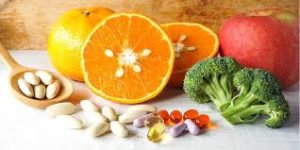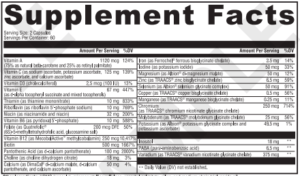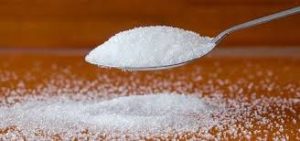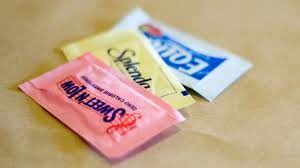Are you taking a multivitamin? It is important to make sure that it is good quality, or you may be wasting your time and money. There are many multivitamins on the market that contain synthetic vitamins, or minerals that are hard to absorb. Sometimes it can be hard to tell whether yours is a good choice!

Your first clue is where you buy your multivitamin. If it came from Walmart, the pharmacy, or the grocery store there is a high probability that it is not great.
Fortunately, you can tell the quality of your multivitamin in just a few minutes by reading the label if you know what to look for. Here is a quick list of things you DON’T want (and what to look for instead).

5 things your multivitamin should NOT contain:
dl-alpha tocopherol
. This is a synthetic form of Vitamin E that does not occur in nature. The natural version is d-alpha tocopherol. Can you see the difference? (You may need to put your reading glasses on for this one!) The synthetic version is dl- and the natural version is d-. Such a small difference on the label, but an important distinction!
Folic acid
You are used to hearing about folic acid and seeing it as an ingredient in fortified foods (and in the vast majority of multivitamins). But did you know that folic acid does not occur in nature? This is another synthetic ingredient used to fortify processed foods. The natural form is folinic acid, or folate. Look for a multivitamin with methylfolate (sometimes abreviated “MTHF”) – the neurologically activated form.
Cyanocobalamin
This is a kind of Vitamin B12, but this form of B12 is not the natural form that is found in your food. “Cobalamin” refers to B12, and “cyano” refers to cyanide – yes, there is a cyanide molecule attached to the B12! This is not going to harm you (it is just not the best kind of B12) but it will certainly help you to remember which one you don’t want! Look for methylcobalamin (or “methylB12”), which is the neurologically activated form.
Calcium carbonate
This form of calcium is hard to absorb (so it doesn’t work very well) but it is cheap for the manufacturer so it is very common. Instead, look for calcium citrate, which is easier to digest and absorb. This is even more important if you are taking a separate calcium supplement. Most of the common calcium supplements you’ll find on the shelf contain calcium carbonate, but calcium citrate is readily available if you take the time to check the labels.
Magnesium oxide
This is another example of a poorly absorbed mineral which is found in most multivitamins. Minerals should be “chelated” (which means they are attached to another molecule for better absorption). Look for one of these chelated forms: magnesium malate, magnesium glycinate, or magnesium citrate. You don’t have to remember all the options – just remember to avoid the one with the X (oxide)!
Also make sure to look at the “inactive ingredients”
Inactive ingredients include the fillers that hold the multivitamin pill together and other ingredients that may have been added, such as artificial colors or preservatives. Here are some things to watch out for:
Food colors
Do you really care what color your vitamin capsule is? Look for colors such as FD&C Red #40, FD&C Yellow #6, and FD&C Yellow # 5. No good quality nutraceutical company would ever put food coloring in their supplements, so this is a major clue that your multivitamin is not high quality.
Sugar

Avoid sugar in any form, including sucrose, fructose, and dextrose. Do I need to even comment about this one?
Artificial sweeteners
S
 weeteners like saccharin, aspartame, acesulfame and sucralose are harmful to your gut bacteria and increase your chances of having blood sugar problems (among other negative health effects). You won’t find these in a high quality multivitamin. Liquid vitamins may have sweeteners to make them taste better – acceptable natural sweeteners include stevia, lo han fruit and monk fruit.
weeteners like saccharin, aspartame, acesulfame and sucralose are harmful to your gut bacteria and increase your chances of having blood sugar problems (among other negative health effects). You won’t find these in a high quality multivitamin. Liquid vitamins may have sweeteners to make them taste better – acceptable natural sweeteners include stevia, lo han fruit and monk fruit.
This is an ingredient list from one of the most popular multivitamins marketed to children. See if you can find any ingredients that are not recommended:
INGREDIENTS: Sucrose, Sodium Ascorbate, Stearic Acid, Maltodextrin, Invert Sugar, Gelatin, Vitamin E Acetate, Artificial and Natural Flavors, Niacinamide, Corn Starch, FD&C Red # 40, FD&C Yellow #6, Magnesium stearate, FD&C Blue #2 Aluminum Lake, Pyridoxine Hydrochloride, Riboflavin, Thiamine Mononitrate, Vitamin A Acetate, Folic Acid, Beta-Carotene, Vitamin D3, Vitamin B12.
The label should also list things that the supplement does NOT contain, like common allergens. Look for a statement like this: “Does not contain wheat, corn, soy, milk, yeast, egg……”

No multivitamin (or any nutritional supplement) can ever compensate for poor nutrition. Eat a healthy diet rich in fruit and vegetables of all colors of the rainbow. Supplementing with a multivitamin can help ensure you are not missing any nutrients, but only if you do your homework and make sure that you are taking a good one!
If you would like to talk to us about optimizing your nutritional status, including testing for nutrient levels or reviewing your current nutritional supplements to make sure you are on the right track – please let us know!
As always –
Living WELL is the best medicine!
Dr Deb





